
Get Business Email
No domain name required
SMTP, or Simple Mail Transfer Protocol, is a set of communications that is used in sending and receiving email. It is one of several email clients' most widely used IP protocols, like Outlook, Gmail, and Yahoo Mail. This protocol is used to send emails from one server to another via the Internet. Setting up the SMTP ensures faster and quicker delivery of emails.
Anyway, if you’re looking for the SMTP setting, you’re at the right place. This article will provide a step-by-step process for Outlook SMTP settings, making email communication seamless.
Whether your SMTP Outlook 365 settings are misconfigured or you are using it for the first time, this guide will provide all the ins and outs.
What is SMTP?
SMTP stands for Simple Mail Transfer Protocol used for email transmission via the Internet. SMTP (send mail) is a push protocol, while POP (post office protocol) or IMAP (internet message access protocol) is used to get emails from the recipient's end. This server works in such a way that an email client like Outlook sends an email to an SMTP server, Outlook, and then forwards it to an additional SMTP server and the recipient’s mail server.
These advanced settings direct email from one server to another, helping to reach their intended recipients. Secure SMTP configuration protects email privacy in Outlook and is a necessity for email service managers.
Key Features
- It is a quick and safe setting for email transmission.
- It includes port, server address, and authentication settings.
- It ensures seamless integration of emails that is configurable and faster.
- It prevents emails from being lost or marked as spam by verifying the sender’s email account before delivering.
- SSL/TLS traffic encryption
- Secure password authentication and hidden IP
- Ensure reliable email exchange and data security.
Pros and Cons of SMTP
This table contains the most common pros and cons of SMTP:
Components Required to Configure SMTP Settings in Outlook
These are some of the key components that you need while configuring the SMTP Outlook 365 settings:
1. Obtaining the Necessary Data
First of all, it is essential to collect all the important information, like:
- SMTP Server Address
To configure SMTP settings in Outlook, you first need to get your SMTP server address. It is usually provided by the email client that helps Outlook connect to send emails.
- Username and Password
After the SMTP server Outlook address, you need to gather your email account credentials (username and password) and authenticate your access to the SMTP server.
- Port Numbers
Port numbers help to identify where the communication process initiates and ends. SMTP servers use several ports for email sending, including 25, 465, and 587.
2. The Outlook SMTP Settings
The table below shows the SMTP settings for Outlook accounts:
3. Accessing Outlook Account Settings
Before SMTP Outlook 365 settings, you need to access the account settings in Outlook. Follow these easy steps:
Step 1: Install Outlook and open the Microsoft Outlook software on the PC.
Step 2: In the Outlook window, visit the “File” tab in the upper left corner. Click on it and launch the “Account Information” page.
Step 3: Next, open the dropdown menu and click “Account Settings” twice. A new window will show the configured email accounts.
Step 4: Choose an email account to configure and click “Change” to access the settings panel.
Easy Step-by-Step Guide to Outlook SMTP Settings for Beginners
Proper SMTP settings are crucial in Outlook to protect email privacy. Here’s a guide that simplifies SMTP setup in Outlook:
Step 1: To initiate the settings for SMTP Outlook, first launch Microsoft Outlook on your PC and sign in with your username and password.
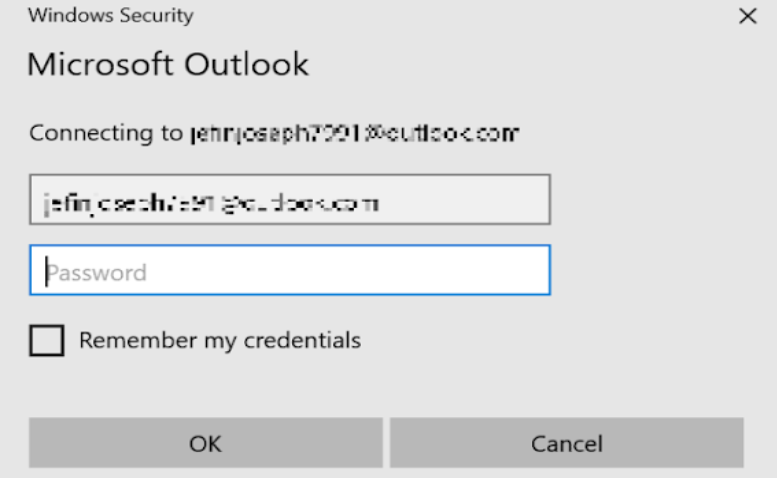
Step 2: To proceed, click on the “File” menu, then select “Info,” and click on “Account Settings.”
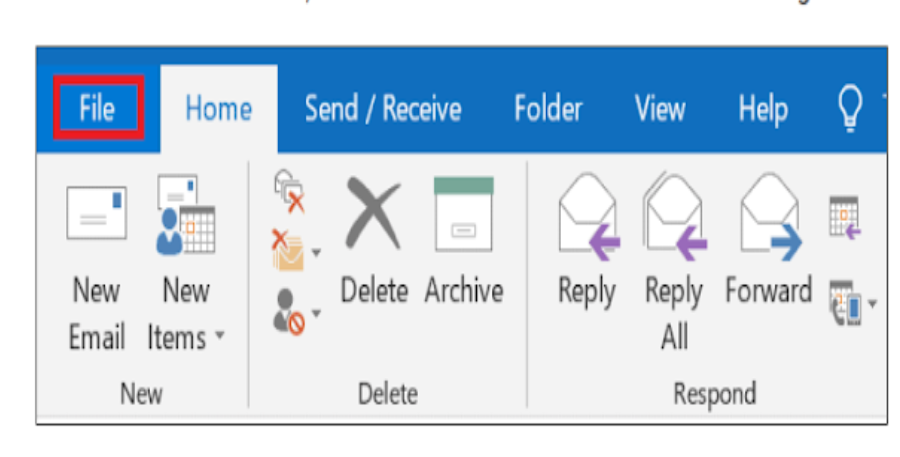
Step 3: In the “Account Settings” drop-down menu, click on “Manage Profiles.”
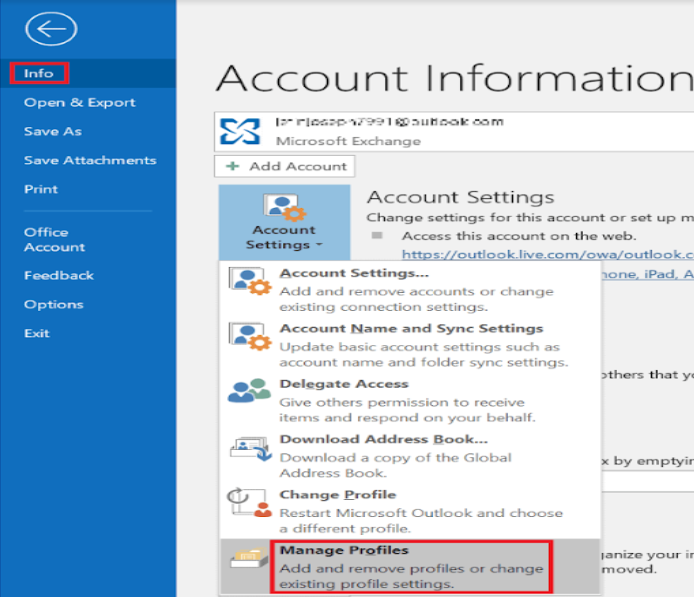
Step 4: A “Mail Setup” window will appear; now click on the “Email Accounts” tab.
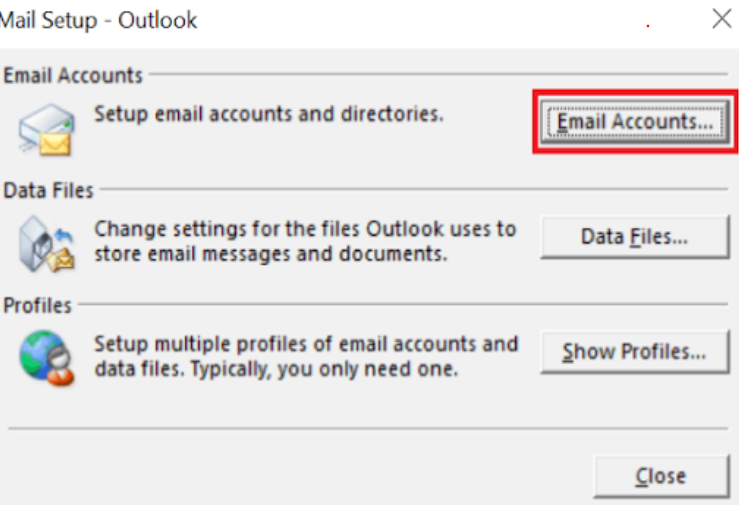
Step 5: Select your email account and click on “Change.”
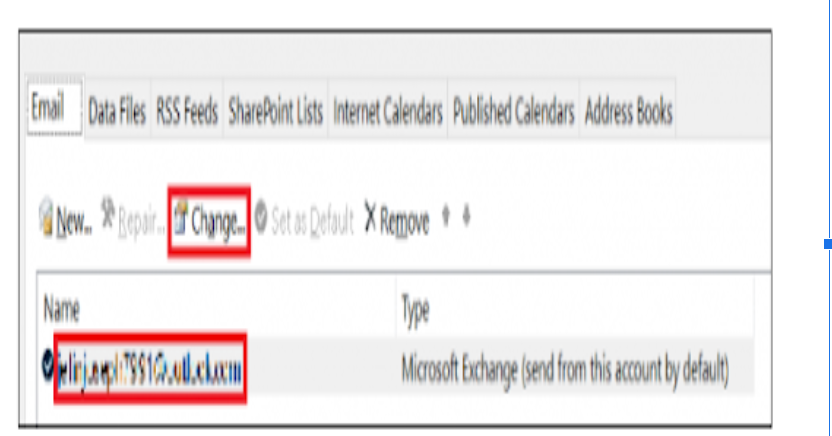
Step 6: In the “Change Account” window, go to “More Settings” and click on it.
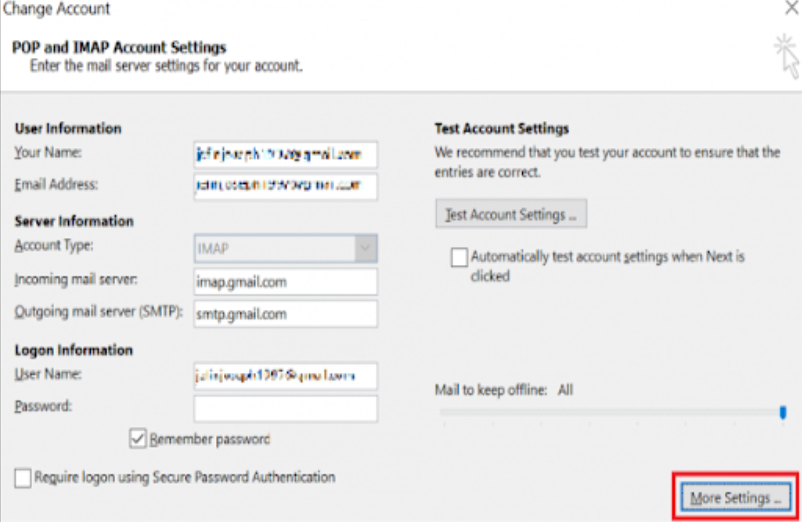
Step 7: Next step, move to the “Outgoing Server” tab and tick the checkbox labeled “My outgoing server (SMTP) requires authentication.” After that, click on “Log on” tab using the radio button. Enter the username and password into the provided space.

Step 9: Click on the “Advanced” tab and choose the “SSL/TSL encrypted connection.” This link is present under the “Use the following type of encrypted connection” dropdown list, and click “OK.”

This marks the completion of the SMTP settings configuration to send emails from non-Outlook accounts through Outlook.
Troubleshooting Common Issues with SMTP Server Outlook Configuration
Some of the most common SMTP Outlook 365 settings obstacles are:
1. Authentication
Sometimes, Outlook is unable to authenticate the user's login details on the mail server. This could be the consequence of an inaccurate username, password, or security settings.
2. Unable to Find the Server
This issue comes up because Outlook is unable to connect with the mail server. It might be the result of an incorrect server address or network error.
3. SMTP server Connection Failed
The failure of the SMTP server Outlook connection might be due to an off or restrictive firewall, port configurations, or server settings.
4. Double-check Credentials
Always verify the username and password while entering the account settings, ensuring no typographical errors or outdated passwords.
5. Security Check
Double-check the security settings to ensure they match those required by the email provider. These settings can be SSL/TLS or authentication methods.
6. Verify Server Address
Please ensure you enter the server address accurately. If in doubt, ask your email provider for the proper SMTP server addresses.
7. Review Port Settings
Ensure you are using the correct port for your SMTP; the most common ports are 25, 587 (for TLS), and 465 (for SSL).
8. Check the firewall and Antivirus Settings.
These software programs occasionally block ports or websites that they find risky. Change your configuration to let Outlook interact with the firewall or turn off antivirus software for seamless processing. Don’t forget to turn them on afterward.
Best Practices for Maintaining SMTP Settings
Following the below-given SMTP best practices while managing an email server ensures seamless email delivery. These include:
1. Prevent SMTP Relay Misuse
Cloud providers block port 25 to control spam. Exercise caution during server setup to prevent open relays. Use SMTP diagnostic tools to test the configuration.
2. Use Professional Mailing Solutions
Port 587 is available for secure email relaying; consider using specialized mailing services for better deliverability.
3. Match Forward and Reverse DNS
Ensure valid and matching forward and reverse DNS as per RFC 1912 to avoid spoofing.
4. Match the HELO String and Reverse the DNS
The HELO/EHLO command should match reverse DNS for identity verification as per RFC 2821.
5. Use Sender Address Verification (SAV)
SAV allows connecting to the return host and verifying whether the site accepts emails from that address. However, it has loopholes, so use it with caution.
6. Secure SMTP with SSL/TLS
TLS 1.3 (the industry standard) is used for email encryption between client and server. TLS reduces the SMTP attack surface and aids data protection.
7. Use Digital Certificates
TLS is compatible with digital certificates that provide a concrete identity and enable a secure handshake process.
8. Monitor Email Server Performance
Routine health checks and email deliverability monitoring help spot potential problems early. Keep server settings updated with the latest security requirements.
Limitation of SMTP Outlook 365
Although SMTP Outlook offers several outstanding features for emailing, it may have some limitations, too. These limitations particularly affect users who require some advanced features or desire to maintain bulk emails:
1. Not Suitable for Bulk Emailing
As mentioned above, Outlook SMTP sets a sending limit of only 100 emails per day. That’s why it can be an ideal choice for small email campaigns but not for larger ones.
2. Attachment Size Limit
Outlook SMTP offers a maximum attachment limit of up to 25 MB. Therefore, for larger files of about 2 GB, OneDrive should be required, which might not be so convenient for sharing large files on a daily basis.
3. Limited Integration and Customization
Outlook SMTP settings provide limited integration and customization options to users, making it less suitable for businesses that require CRM integration.
Neo: A Trustworthy Provider of SMTP Services

Neo is the next-gen business email provider that utilizes SMTP protocol to ensure effective and secure email exchange. It is designed to meet the ever-changing needs of entrepreneurs and small businesses, especially in managing their email marketing efforts.
Its SMTP server used high-tech tools for creating emails and managing mailing lists. With Neo SMTP, you can manage contacts and send bulk emails in just a few minutes.
Apart from these, Neo offers several other useful services, including a cloud email tracking service, generative AI, and the “Advanced Mass Sender,” which assists in effective writing and projecting a unique brand image.
How to Configure Neo on Outlook?
To configure your Neo account in Outlook SMTP settings, you need to follow these steps:
Step 1: Open your Outlook and log into your account. Then, look for the “File” tab and click on it.
Step 2: In this step, an “Account Information” screen will appear; then click on “Add Account.”
Step 3: Now, type your Neo email address and select “IMAP” as the account type.
Step 4: Enter the password for the same email box, and you should be able to access your Neo email box.
Step 5: Enter the following configuration:
Step 6: Ensure checking the “Require logon using Secure Password Authentication (SPA)” box, and then click on “Next.
Step 7: After the email address is processed, your screen will show a message stating “Account Successfully Added.” To complete the installation, click “Done.” That’s it! Your account is now ready to use Outlook.
Wrapping Up,
Accurately configuring Outlook SMTP settings is necessary for optimal performance and better email deliverability. Following a few simple steps, including account settings, authentication, and encryption protocols, is all required.
Once you’ve completed the Outlook account settings, it’s crucial to verify that everything works properly. If you follow this approach thoroughly, your emails will constantly reach the targeted audiences, and you will minimize the risk of your email being marked as spam.
Don’t forget about the troubleshooting issues and the best practices to keep your Outlook running seamlessly and securely. You can also configure your Neo mail on Outlook, one of the most reliable platforms for email communication.
Frequently Asked Questions (FAQs)
1. What is SMTP?
SMTP is a communication protocol used to send and receive email via the Internet. To send an email to recipients, you need an SMTP server. Initially, SMTP used port 25; now, it uses port 587.
2. What is an SMTP server error?
An SMTP server error implies bouncing back of incoming or outgoing messages. Check the bounce messages for an SMTP error code, which will help you fix the error.
3. How does SMTP handle emails?
SMTP is one of the most famous protocols used worldwide. It is used to transmit emails between different servers. The SMTP process initiates. Once the email is sent, it will reach an SMTP server. This server divides a set of rules to figure out where the email has to be transmitted next.

Get Business Email
No domain name required





.svg%201.svg)
.svg)
.svg)
.svg%201.svg)



